Conquering Kilimanjaro: Essential Cold Weather Trekking Gear Guide
Reaching the summit of Mount Kilimanjaro is a dream for many adventurers around the globe. As the highest peak on the African continent, Kilimanjaro challenges trekkers with its rugged terrain and varied climates. The journey to Uhuru Peak is not only a test of physical endurance but also a pilgrimage through stunning ecological systems. To ensure a successful and enjoyable trek, it is crucial to be adequately prepared, especially for the colder conditions you'll encounter as you ascend. At Kilimanjaro Centre for Trekking and Ecotourism (KCTE), we believe that the right gear is your best ally against the mountain's extremes. In this guide, we'll walk you through the essential Kilimanjaro trekking gear for cold weather, ensuring you're well-equipped for the adventure of a lifetime.
Understanding Kilimanjaro's Climate
Before diving into gear specifics, it's important to understand what you're up against. Kilimanjaro features a range of climates from tropical at the base to arctic conditions at the summit. The temperature decreases as you ascend, dropping as low as -20°C (-4°F) at the top. Preparing for these conditions is crucial for a safe and successful climb.
The Layering System: Your Cold Weather Mantra
Base Layer: The Second Skin
The foundation of your cold weather gear starts with the base layer. This layer is crucial as it sits directly against your skin, managing body moisture and retaining body heat. Opt for materials like merino wool or synthetic fibers that provide insulation even when wet. Avoid cotton as it retains moisture, which can lead to rapid heat loss.
Mid Layer: The Insulator
Your mid-layer serves as the primary insulating component. Fleece jackets or down vests work excellently in trapping heat. Look for options that offer warmth without excessive bulk, as mobility is key when tackling Kilimanjaro's diverse terrain.
Outer Layer: The Protector
The outermost layer, or shell layer, is your main defense against wind and precipitation. A good quality, breathable, and waterproof jacket and pants are paramount. Ensure that your outer layer provides ample ventilation to prevent overheating and perspiration buildup.
Extremities: Protecting Hands, Head, and Feet
Gloves and Mittens
Cold hands can turn a challenging trek into a miserable experience. Invest in waterproof and insulated gloves or mittens to keep your fingers warm and agile. Consider bringing a lighter pair for lower elevations and a heavier pair for the summit push.
Hats and Balaclavas
Much of your body heat is lost through your head, so covering it is essential in cold climates. A wool or fleece hat that covers the ears will protect against the chill. Additionally, a balaclava can offer face protection from biting winds at higher altitudes.
Footwear: Your Foundation
Good quality, insulated, and waterproof hiking boots are indispensable. They must also provide excellent ankle support. Pair your boots with thermal socks to keep your feet warm and moisture-free, reducing the risk of blisters and frostbite.
Additional Kilimanjaro Specific Gear
Sleeping Gear for Subzero Nights
Your sleeping bag should be rated for at least -10°C (14°F), though a -20°C (-4°F) rating is ideal for the colder nights. Consider a sleeping bag liner for extra warmth and hygiene.
Accessories for Comfort and Safety
Don't forget a headlamp for those early morning or late evening treks, especially useful during your summit attempt. UV-protective sunglasses are crucial to protect your eyes from intense sun reflections off the snow. Also, a sturdy, insulated water bottle is a must to prevent your water supply from freezing.
Packing Smart: The Key to a Hassle-Free Climb
Packing efficiently can make a significant difference in your climbing experience. Balance between packing essential cold weather gear and keeping your load manageable. Every piece of gear should serve a purpose and, ideally, more than one.
Why Choose KCTE for Your Kilimanjaro Adventure?
At Kilimanjaro Centre For Trekking and Ecotourism (KCTE), we don't just prepare you for the trek; we ensure you embark on this journey with confidence and return with a heart full of memories. Our expert guides and porters are well-versed in the unique challenges of Kilimanjaro and are equipped to provide you with a safe, enjoyable, and enriching climbing experience. Choosing KCTE means opting for excellence in service and commitment to ecological conservation.
Ready to Embark on Your Kilimanjaro Quest?
Preparation is the key to conquering Mount Kilimanjaro. Equip yourself with the necessary cold weather gear and choose a trusted partner like KCTE to guide you through this majestic mountain terrain. Whether you're a seasoned climber or a passionate trekker looking for your next big adventure, Kilimanjaro awaits with its unparalleled beauty and exhilarating challenges.
Book your Kilimanjaro climb with Kilimanjaro Centre For Trekking and Ecotourism today and stand atop Africa, fulfilling a dream with every step you take.
Frequently Asked Questions
What is the best time of year to climb Kilimanjaro?
The best times to climb Kilimanjaro are during the dry seasons: January to mid-March and June to October. These months offer the clearest skies and safest climbing conditions.
How long does it take to climb Kilimanjaro?
The climb typically takes about 5 to 9 days, depending on the route chosen. Adequate acclimatization days are crucial for a successful summit attempt.
Do I need a guide to climb Kilimanjaro?
Yes, a guide is required to climb Kilimanjaro. KCTE provides experienced guides to ensure your safety and enhance your climbing experience.
Can I rent gear from KCTE?
Yes, Kilimanjaro Centre For Trekking and Ecotourism offers gear rental services. We provide high-quality gear suited for the harsh conditions of Kilimanjaro.
Embrace the cold, conquer the heights, and discover your strength on the slopes of Kilimanjaro with KCTE.




